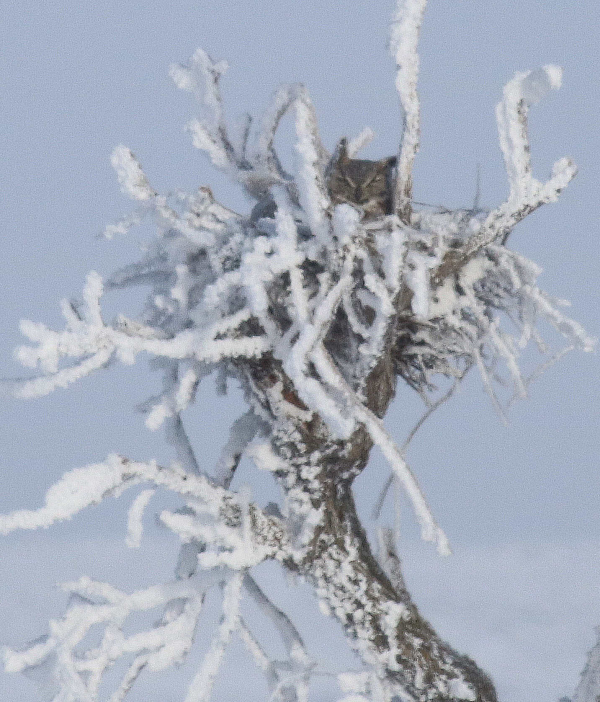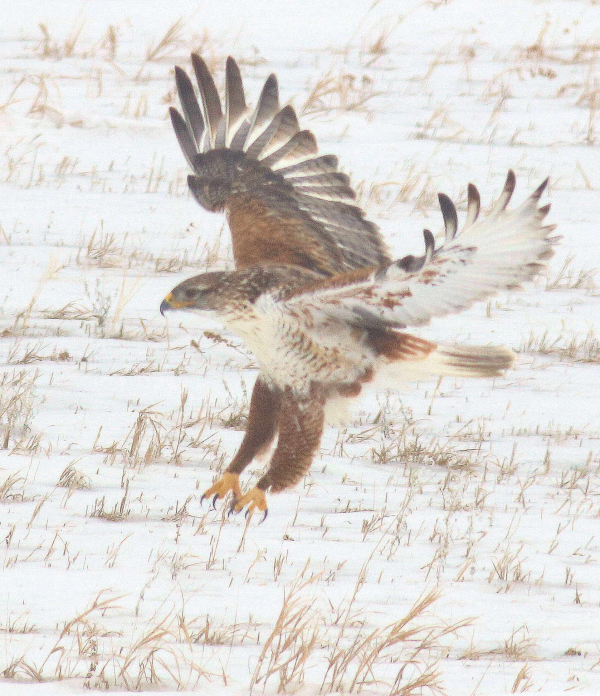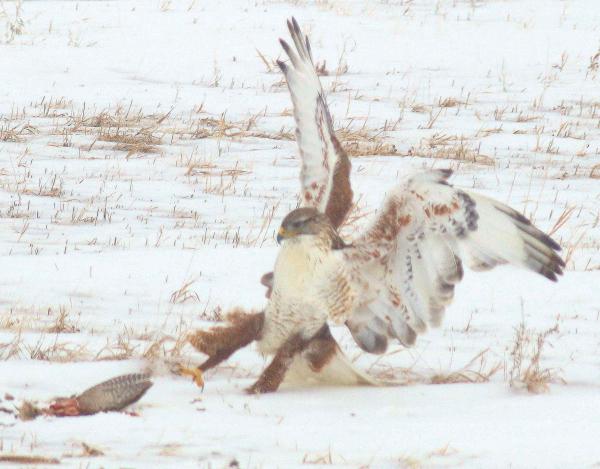
The frosty Great Horned Owl incubating on a very frosty nest.

The male Ferruginous Hawk in flight to claim second-hand food.

|
Building on the two Great Horned Owl nests I found last week, last Monday I photographed nest number two (the former Ferruginous Hawk nest) with the incubating Great Horned Owl amid a heavily frosted nest and tree. In fact, the owl had some frost formed on the southwest side of its face, including one “horn.” After my quick stop at the owl nest, I continued driving south, headed for my SoDak raptor area with the promise of a couple days of sunshine. It seems I’ve been chasing the sunlight too often lately; although a couple weeks ago it worked to my definite advantage.
But throughout the morning I passed through small areas of fog that seemed to burn off with the warming sun. I photographed the first Golden Eagle (a first-year bird) with the delight of having it bank and fly directly toward me, passing very close overhead. Soon I passed a couple Rough-legged Hawks and a flock of Ring-necked Pheasants, a loafing regal Bald Eagle, an adult Golden Eagle – then I entered another curtain of fog; but this time, the fog didn’t break until I was 30 miles down the road in Pierre.
My ultimate destination is really another 30 miles south of Pierre, so I pressed southward, only to encounter a seemingly never-ending fog bank. There were more Rough-legs along the way, but when I reached the entrance to the promised land – a gravel road that bisects an area where I usually encounter a remarkable number and variety of birds of prey. But a few yards down the road, it was obvious that the warming weather wasn’t going to work in my favor either. The road was pretty soft (muddy) already, and it was obvious the chances of getting stuck in a remote area weren’t worth risking in the fog. (If the sun was out, I probably would have given it a try, but if I didn’t get stuck, I would have torn up the road a bit, and my van would have looked like an off-roading mud truck.)
I had already conceded that things probably weren’t going to work out in this excellent wintering raptor area, and with the promise of sunshine if I returned north of Pierre, I turned off the muddy road after a mile and crossed to a paved rural road to retrace my route back to the capitol city. But just as I turned onto the highway, two hawks standing in the open snow caught my attention. A Red-tailed Hawk stood warily with feathered prey “in hand,” facing a Ferruginous Hawk. The Red-tail was surrounded by an inordinate amount of feathers, so I probably came upon the scene soon after the Ferrug arrived, as the Red-tail had fed on most of what turned out to be a hen pheasant.
As if the Red-tail wasn’t on edge enough with the Ferrug planning its next move, when I stopped behind it, the Red-tail was definitely edgy and, having fed already, it took flight. The Ferruginous Hawk on the other hand, had the prey remains in mind and took a moment to check me out before it took a quick flight to the leftovers. I photographed the low flight, along with a few initial feeding images. Ferruginous Hawks have been all but absent in the SoDak raptor area this winter, which made me wonder if this one was on its return trip north.
During my return northward, I enjoyed photographing a male dark-morph Rough-legged Hawk in flight close to my window (but in the fog), and checked out other raptors and pheasants along the way. The sun broke through the fog again about 50 miles north of Pierre, but I didn’t get any more sunny photos until I was about 20 miles north of the Dakota border, where I checked out the Bald Eagle nest I noted a few weeks ago. Sure enough, there was a Bald Eagle perched next to the huge nest, but I couldn’t see any hint of a bird on the nest – just snow.
My last bird of the day, aside from the almost ever-present Horned Larks, was a surprise that I had to reverse course and take a second look at to confirm. As I drove over a high hill about 25 miles west of home, amid a sea of unending snow, I spied what could have been a snow-covered rock, but something beyond eyesight alone made me turn around and give it a second look. Through my binoculars I could see that, sure enough, the snowy rock was actually a beautiful fluorescent white adult male Snowy Owl – whoo, whoo! This beauty was standing just below the crest of the hill, out of the wind, where it beamed white in the light of the setting sun. He was Snowy Owl number 20 for this winter, and because it’s been about five weeks since I found my last Snowy, and because it’s getting late in the year for Snowys, this might be the last one I see this season.
Well, that was quite a day, even though I returned home a day earlier than planned. Birding opportunities would be limited the rest of the week. Wednesday, another huge blizzard hit with 40 mile per hour winds and gusts to 56 blowing another foot of snow across the landscape! I’ve dubbed this “the winter of blizzards,” and hope that’s the last one. C’mon spring!
P.S. Friday morning I had a new species visiting my feeding station, a brightly colored male Common Redpoll. It only remained long enough to identify it, which was a bit disappointing, but it has returned daily to immerse itself in nyjer seeds for a while, along with other finches – Pine Siskins and American Goldfinches – hooray!
P.S.S. Sunday afternoon, three miles to the south, I spied the first obvious bird migrating north – an American Crow – a real breakthrough as the week begins that will yield the first official day of spring.
Article and photos by Paul Konrad
Share your bird sightings and photos at editorstbw2@gmail.com